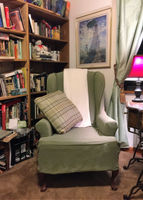Years ago, when my sister and I were first getting acquainted as adults (a process quite different than growing up together) we discussed a book called Mrs. Frisby and the Rats of NIMH. Barb and I agreed it was very good but my sister added, “It doesn’t compare to the author’s first book, The Silver Crown.” I had missed that kid’s book and couldn’t imagine how anything could approach the charm of NIMH. “Try The Silver Crown and see” Barb said. “You’ll like it, it’s scary as all get out.” As usual, my sister was right.
The Silver Crown is, I suppose, a modern fairy-tale. A young girl, Ellen Carroll, wakes on her birthday to find a crown made of dense silver material beside her bed. She takes the crown outdoors to enjoy some solitude and returns to find her home afire and her family gone. As the day goes on it becomes very clear that the fire was the first step in someone’s campaign to capture Ellen and her crown. Ellen has to run and stay one step ahead of her enemies in order to survive. It isn’t easy.
The thing is, while The Silver Crown has some very disturbing elements, it’s told in a matter-of-fact manner that minimizes the traumatic implications. Ellen sees someone murdered but the the incident is described impressionistically. Someone wearing a green hood fires a gun at a man, the man’s face goes red and he falls. Ellen realizes what’s happened but because she doesn’t dwell on the violent aspects, the trauma doesn’t damage her (or the reader). Far more fear is generated when Ellen sees the green hood in the glove compartment of another man who gives her lift down the highway.
That air of acceptance permeates this kid’s novel and allows the reader to accept a lot of statements at face value and get on with the story. When Ellen first puts on her silver crown, it fits her head as if it was made for her and she accepts this because Ellen is convinced that in some reality, she is a queen. Because Ellen accepts it, eventually the reader does as well. Ellen is a queen and this crown suits her because it is her crown. The crown has a power of its own, like Frodo’s ring, and Ellen must learn to wield it. It helps that Ellen is one of the most self-possessed girls in juvenile literature since Sara Crewe or Alice in Wonderland. Her character strength is the central appeal in The Silver Crown and what makes the book a good choice for childen to read. By facing fear, Ellen shows her readers how to cope with it.
The book has been the subject of some controversy and when it was originally published in the U. S., a different, more conventional ending was added. I prefer the British one. It’s stronger, and more believable, if a bit sadder. I believe it pays greater respect to the reader’s imagination, even if the reader is young.
After all, no matter what parents do, childhood holds no small amount of terror. Children have no control over their lives and they face the unknown with each new experience, whether it’s a whole new environment such as a new school or home or it’s a new element in that environment, like a classmate or a stranger. Books like The Silver Crown say it’s all right to be scared and that some fears are not groundless; even a queen must be careful when venturing out into the wide world. The book also says that good sense and basic confidence can help a scared child and the world holds good people as well as bad. So, despite the disturbing elements, child readers can identify with the heroine and use her example to face more pedestrian fears. For that reason alone, I think The Silver Crown is worthwhile reading. Yes, I’d prefer that all children know nothing but the joy and peace of spring and the sun, but they don’t. And I believe no one can truly appreciate the sun until they’ve walked for a while in the dark.

No Comments
Comments are closed.